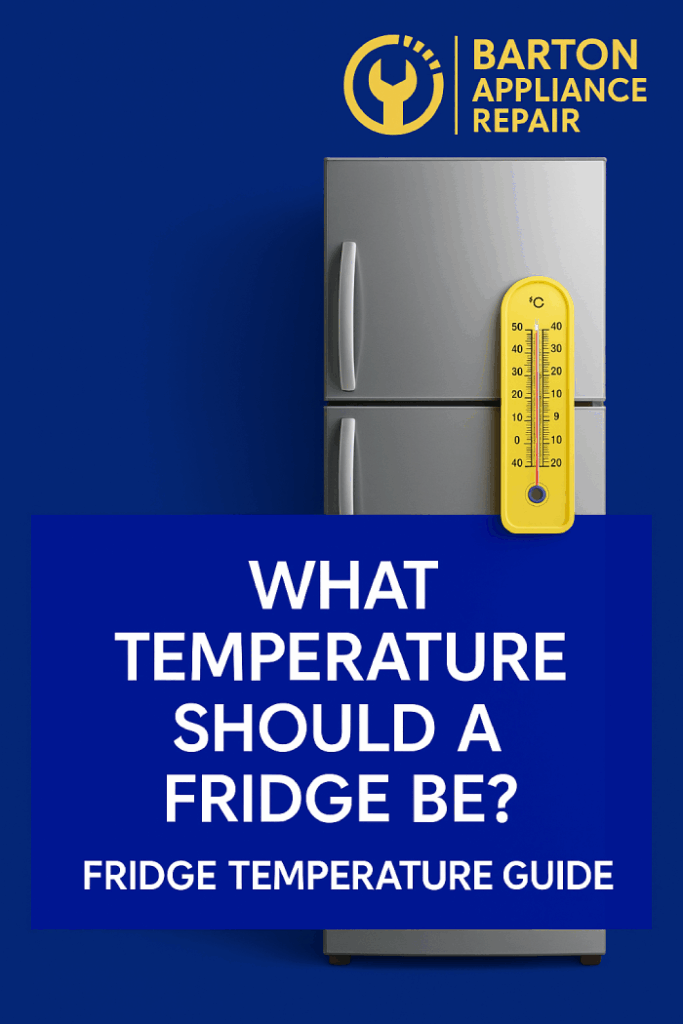If your fridge runs too warm, your food will spoil faster. Too cold? You will have to say goodbye to crisp lettuce and hello to cracked eggs. So, what’s the optimal fridge temperature that keeps everything fresh and safe, especially for the Canadian climate and food standards?
This quick guide will tell you about the right temperature for the fridge, why it’s so important, how to check it, and what to do if things feel a little off.
What Is the Best Temperature for a Fridge?
Let’s not overcomplicate it:
The ideal fridge temperature is between 1.6°C and 3.3°C (35°F to 38°F).
This range keeps bacteria growth in check while avoiding freezer burn on your fresh produce.
- Above 4°C (40°F)? You’re entering the bacteria danger zone.
- Below 0°C (32°F)? You risk freezing foods that aren’t meant to freeze.
Basically, you want that sweet middle ground, not too cold, not too warm.
Why Fridge Temperature Matters?
Your fridge doesn’t just chill your groceries, it helps protect your health.
So, when the temperature goes too high, harmful bacteria like Salmonella or Listeria can grow fast, especially in dairy, meat, and even leftovers. And when things get too cold? Your lettuce wilts, milk might curdle, and eggs can even freeze and crack.
It matters because a properly set fridge reduces food waste, preserves taste and texture, and lowers the risk of any type of foodborne illness. Small change, big payoff.
How to Know If Your Fridge Is at the Right Temperature?
Fridge dials are very vague. Most show numbers (1 to 7) or broad settings like ‘cold’ or ‘coldest’, not the actual temperature.
So, here’s the simplest fix:
Use a fridge thermometer. You can get one for $10-15 CAD. Place it in the center of the middle shelf, not near vents or walls. After any adjustment, give it at least 24 hours before you recheck.
Pro Tip: The back and the bottom of the fridge are usually colder. The door? Warmest spot. That’s why milk and eggs don’t belong there. They are better when kept in the main body.
What Temperature Should a Freezer Be?
Your freezer temperature should be set at -18°C (0°F).
This is the standard recommended by Health Canada to keep food safe for long-term storage. It will stop bacterial growth and keep frozen food safe for a long. Just don’t assume “frozen equals forever”. For best quality, try to eat most frozen items within 3-6 months.
Best Fridge Zones for Different Types of Food
Proper storage isn’t just about what you put in the fridge, but where you put it. Different areas have slightly different temperatures, and using them well helps in keeping your food fresher.
Here’s how to make the most of your fridge space:
- Top Shelf: Leftovers, drinks, snacks
- Middle Shelf: Dairy like milk, cheese, yoghurt
- Bottom Shelf: Raw meat/fish (in a tray to catch any drips)
- Crisper Drawers: One for veggies (high humidity), one for fruit (low humidity)
- Door: Condiments, butter, juice, the items that are less sensitive to temperature swings
Pro Tip for Canadian winters: Keep your garage fridge in check. Outside cold temperatures can confuse the thermostat and mess with the cooling cycle.
Signs Your Fridge Temperature Might Be Off
Your food usually tells the story. Look for:
- Spoiled milk before the expiry date.
- Frozen fruits or veggies in the crisper.
- Ice forming in the fridge (not the freezer).
- Funky smells or strange textures.
- Water puddles are forming inside.
If something feels off, check with a thermometer before assuming the fridge is broken. A minor dial adjustment could save hundreds in wasted groceries.
How to Keep Your Fridge Temperature Steady?
Once you’ve nailed the right temperature, here’s how to maintain it:
- Don’t overpack: Air needs space to circulate
- Clean your condenser coils: At least twice a year
- Check your door seal (gasket): Replace it if it’s loose or cracked
- Let food cool before storing: Hot leftovers can spike internal temperatures
- Limit door openings: Especially in summer or humid weather
Regular checks and minor habits go a long way in keeping things running efficiently.
What About Smart Fridges in Canada?
Got a digital display? Even better. Set your smart fridge to 3°C (37°F) for best results. Some models even sync with apps and notify you if the door’s open too long or if the temperature spikes during a power outage.
Still, it doesn’t hurt to keep an analog thermometer around as a backup, especially during winter blackouts or summer heat waves.
FAQ: Quick Answers for Canadians
- Is 5°C okay for a fridge?
Not really. 5°C (41°F) is slightly too warm. Lower it to stay below the Canadian food safety threshold of 4°C. - Can a fridge be too cold?
Yep. Below 0°C, food can freeze. That’s fine for raw meat, but not for your salad or fresh berries. - Does a fuller fridge stay colder?
Not exactly. While a mass holds temperature, an overpacked fridge blocks airflow. Stick to around two-thirds full for efficiency. - How do I know if my fridge is too warm?
Use a thermometer. If your dairy goes bad early or your leftovers smell off, it’s time to check.
Final Word: Fridge Temperature Canada Edition
To sum it up:
- Fridge: 1.6°C to 3.3°C (35°F to 38°F)
- Freezer: -18°C (0°F)
That’s the sweet spot for Canadian households, balancing food safety, quality, and energy efficiency.
Fridge Not Cooling?
If your fridge still isn’t cooling right, even after adjusting the settings, there could be a bigger issue: broken sensors, faulty thermostats, or clogged vents.
That’s where we step in.
Barton Appliance Repair provides professional fridge repair across Vancouver. Whether it’s not cooling, running loudly, or freezing food unexpectedly, we’ll get it fixed quickly and properly.
Call us or book online to get your fridge back on track today.

